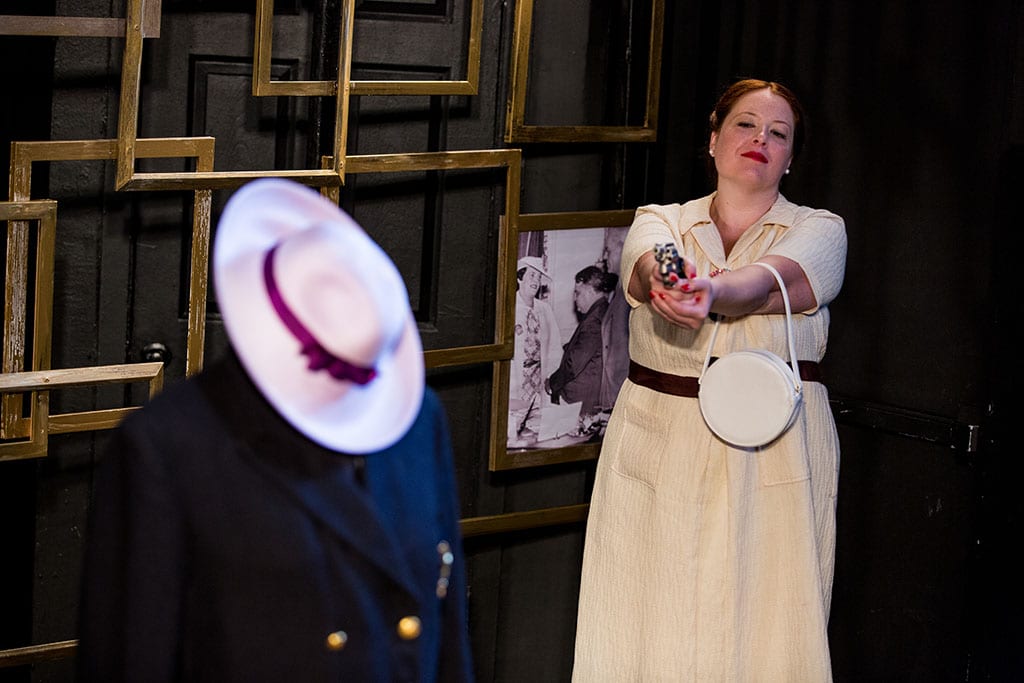Before seeing Dead Shot Mary, I read about the achievements and exploits of Mary Shanley, the focus of the one-woman show now playing at Shetler Studios. Shanley was one of the first women to earn the rank of first-grade detective, and had a storied career with the NYPD. I noticed an upcoming performance was reserved for the Policewomen’s Endowment Association. Sergeant Nora Ahmed, the association’s president, said, “They’re bringing attention to what this woman did as a trailblazer in the department, and it’s great to see that brought to life.”
How, I wondered, could all the groundbreaking activities of this real-life police drama be staged in a tiny theater with a cast of only one and feared the play would fail to capture the astonishing deeds and heroic acts of this larger than life character on the forefront of feminism.
Indeed, Detective Shankey is recognized as the first policewoman to fire a gun—she actually shot into the air—during an encounter with a perpetrator. She’s also credited with arresting over a thousand pickpockets, shoplifters, fortune-tellers, and swindlers during a 26-year career, spanning from 1931 to 1957. In addition, Shanley received a commendation in 1937 from Mayor Fiorello La Guardia for thwarting an armed robbery and singlehandedly arresting the two suspects. Later, using her leather handbag as a weapon, she floored and apprehended a shoplifter at Macy’s in Herald Square and, in a separate incident, captured a suspect attempting to steal a woman’s unattended purse at a movie theater, despite being punched in the face and thrown to the floor. Many of Detective Shanley’s law enforcement achievements were well documented in newspaper articles throughout her long career, although she’s been largely forgotten today.
As it turned out, the play was not at all about the arrests, awards, adventures, or antics of one of the first female detectives in law enforcement history. It was also not about what Detective Shanley accomplished “as a trailblazer in the department.” Instead, Dead Shot Mary portrays the existential fear and angst embodied in one woman’s struggle to endure as she grows old alone, unaided, unaccompanied, unwanted, and uncherished. One senses that throughout her career, like many other women in law enforcement, Mary had been excluded from the thin blue line, an exclusion that undoubtedly intensifies her current isolation. And like others struggling to cope with loneliness and seclusion, Shanley turns to the bottle, obviously an escape she’d honed during her years as a detective.
For companionship, Mary has a dog, Jiggs, as others might under comparable circumstances. During a particularly poignant scene, she tells Jiggs, “You’re all I have in my life, and you’re all I need.” One believes the first part, but highly doubts the veracity of the second. When Jiggs dies, she’s left only with her memories of more auspicious times. To contend with her solitude, she relives for the audience her past line of duty escapades, and it is only through these reminiscences that we learn anything at all about her law enforcement career. Still, these tales of arrests, gunplay, and gallantry are clearly ancillary to the central theme of this compelling, heartrending account of a life coming unraveled.
The ebb and flow of Detective Shanley’s emotional crisis is well rendered in the imaginative script by Robert Benson, and commendably delivered in a very skilled performance by veteran actor Rachel McPhee. The theater is small and cramped, but this hardly distracts from a profoundly absorbing and stimulating experience. I highly recommend Dead Shot Mary, particularly for those capable of grappling with some of life’s harshest realities.

